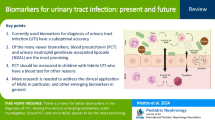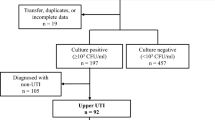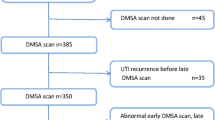Abstract
Background
Distinguishing between urinary tract infection (UTI) and colonization (UTC) in patients with neurogenic bladders who require clean intermittent catheterization (CIC) is difficult. Urinary neutrophil gelatinase-associated lipocalin concentrations (uNGAL) are increased in UTIs. Our objective was to determine the predictive accuracy of uNGAL for UTI in CIC-dependent children.
Methods
Cross-sectional study of CIC-dependent patients from August, 2015 to November, 2016. UTI was defined as (1) growth of ≥ 50,000 cfu/mL of a uropathogen, (2) > 10 urinary white blood cells/hpf, and (3) ≥ 2 of the following: temperature > 38 °C, abdominal pain, back pain, worsened incontinence, pain with catheterization, or malodorous/cloudy urine. Positive urine cultures that did not meet these criteria were grouped as UTC, and negative cultures were grouped as no growth.
Results
Two hundred one patients were included (no growth = 100, UTC = 77, UTI = 24). Median (interquartile range) uNGAL was higher in the UTI group (UTI 1361 (931, 2516) μg/g creatinine, UTC 246 (106, 548) μg/g creatinine, no growth 36 (11, 179) μg/g creatinine, p < 0.01 for all comparisons). The area under the ROC curve for uNGAL for UTI versus no UTI was 0.89, 95% CI (0.80–0.98).
Conclusion
uNGAL is elevated in CIC-dependent children with UTI compared to those with negative cultures and those with UTC.


Similar content being viewed by others
References
Dedeić-Ljubović A, Hukić M (2009) Catheter-related urinary tract infection in patients suffering from spinal cord injuries. Bosn J Basic Med Sci 9:2–9
Forster CS, Courter J, Jackson E, Mortensen J, Haslam D (2017) Frequency of multidrug-resistant organisms cultured from urine in children on clean intermittent catheterization. J Pediatric Infect Dis Soc 6:332–338
Lin J-N, Chen Y-H, Chang L-L, Lai C-H, Lin H-L, Lin H-H (2011) Clinical characteristics and outcomes of patients with extended-spectrum β-lactamase-producing bacteremias in the emergency department. Intern Emerg Med 6:547–555
Schmidt-Ott KM, Mori K, Li JY, Kalandadze A, Cohen DJ, Devarajan P, Barasch J (2007) Dual action of neutrophil gelatinase-associated lipocalin. J Am Soc Nephrol 18:407–413
Flo TH, Smith KD, Sato S, Rodriguez DJ, Holmes MA, Strong RK, Akira S, Aderem A (2004) Lipocalin 2 mediates an innate immune response to bacterial infection by sequestrating iron. Nature 432:917–921
Hatipoglu S, Sevketoglu E, Gedikbasi A, Yilmaz A, Kiyak A, Mulazimoglu M, Aydogan G, Ozpacaci T (2011) Urinary MMP-9/NGAL complex in children with acute cystitis. Pediatr Nephrol 26:1263–1268
KDIGO AKI Work Group (2012) KDIGO clinical practice guidelines for acute kidney injury. Kidney Int Suppl 2:1–138
Bone RC, Balk RA, Cerra FB, Dellinger RP, Fein AM, Knaus WA, Schein RM, Sibbald WJ (1992) Definitions for sepsis and organ failure and guidelines for the use of innovative therapies in sepsis. The ACCP/SCCM Consensus Conference Committee American College of Chest Physicians/Society of Critical Care Medicine Chest 101:1644–1655
Mishra J, Dent C, Tarabishi R, Mitsnefes MM, Ma Q, Kelly C, Ruff SM, Zahedi K, Shao M, Bean J, Mori K, Barasch J, Devarjan P (2005) Neutrophil gelatinase-associated lipocalin (NGAL) as a biomarker for acute renal injury after cardiac surgery. Lancet 365:1231–1238
Madden-Fuentes R, McNamara E (2013) Variation in definitions of urinary tract infections in spina bifida patients: a systematic review. Pediatrics 132:132–139
R: A language and environment for statistical computing (2013) Available from https://www.r-project.org/
Robin X, Turck N, Hainard A, Tiberti N, Lisacek F, Sanchez JC, Muller M (2011) pROC: an open-source package for R and S+ to analyze and compare ROC curves. BMC Bioinformatics 12:77
Fleming-Dutra KE, Hersh AL, Shapiro DJ, Bartoces M, Enns EA, File TM, Finkelstein JA, Gerber JS, Hyun DY, Linder JA, Lynfield R, Margolis DJ, May LS, Merenstein D, Metlay JP, Newlang JG, Piccirillo JF, Roberts RM, Sanchex GV, Suda KJ, Thomas A, Woo TM, Zetts RM, Hicks LA (2016) Prevalence of inappropriate antibiotic prescriptions among US ambulatory care visits, 2010-2011. JAMA 315:1864
Dotis J, Printza N, Marneri A, Gidaris D, Papachristou F (2013) Urinary tract infections caused by extended-spectrum beta- lactamase-producing bacteria in children : a matched case- control study. Turk J Paediatr 55:571–574
Subcommittee on Urinary Tract Infection, Steering Committee on Quality Improvement and Management, Roberts KB (2011) Urinary tract infection: clinical practice guideline for the diagnosis and management of the initial UTI in febrile infants and children 2 to 24 months. Pediatrics 128:595–610
Vaidyanathan S, Soni BM, Dundas S, Krishnan KR (1994) Urethral cytology in spinal cord injury patients performing intermittent catheterisation. Paraplegia 32:493–500
Schlager TA, Grady R, Mills SE, Hendley JO (2004) Bladder epithelium is abnormal in patients with neurogenic bladder due to myelomeningocele. Spinal Cord 42:163–168
Bachur R, Harper MB (2001) Reliability of the urinalysis for predicting urinary tract infections in young febrile children. Arch Pediatr Adolesc Med 155:60–65
Branson D (1966) Evaluaion of a rapid nitrate screening test for bacteriuria. Tech Bull Regist Med Technol 36:288–291
Fouts DE, Pieper R, Szpakowski S, Pohl H, Knoblach S, Suh MJ, Huang ST, Sprague BM, Lucas SK, Torralba M, Nelson KE, Groah SL (2012) Integrated next-generation sequencing of 16S rDNA and metaproteomics differentiate the healthy urine microbiome from asymptomatic bacteriuria in neuropathic bladder associated with spinal cord injury. J Transl Med 10:174
Powell H, McCredie D, Ritchie M (1987) Urinary nitrite in symptomatic and asymptomatic urinary infection. Arch Dis Child 62:138–140
Schlager TA, Dilks S, Lohr J, Hayden GF, Kopco J, Hendley JW (1992) Periurethral colonization and urinary leukocytes as markers for bacteriuria in children with neurogenic bladder. Urol Res 20:361–363
Paragas N, Kulkarni R, Werth M, Schmidt-ott KM, Forster C, Deng R, Zhang Q, Singer E, Klose AD, Shen TH, Francis KP, Ray S, Vijayakumar S, Seward S, Bovino ME, Xu K, Takabe Y, Amaral FE, Mohan S, Wax R, Corbin K, Sanna-Cherchi S, Mori K, Johnson L, Nickolas T, D’Agati V, Lin CS, Qui A, Al-Awqati Q, Ratner AJ, Barasch J (2014) The alpha-intercalated cell defends the urinary system from bacterial infection by excreting H+ and LNC2 in mouse and human urine. J Clin Invest 124:2963–2976
Mori K, Lee HT, Rapoport D, Drexler IR, Foster K, Yang J, Schmidt-Ott KM, Chen X, Li JY, Weiss S, Mishra J, Cheema FH, Markowitz G, Suganami T, Sawai K, Mukoyama M, Kunis C, D’Agati V, Devarajan P, Barasch J (2005) Endocytic delivery of lipocalin-siderophore-iron complex rescues the kidney from ischemia-reperfusion injury. J Clin Invest 115:610–621
Yilmaz A, Sevketoglu E, Gedikbasi A, Karyagar S, Kiyak A, Mulazimoglu M, Aydogan G, Ozpacaci T, Hatipoglu S (2009) Early prediction of urinary tract infection with urinary neutrophil gelatinase associated lipocalin. Pediatr Nephrol 24:2387–2392
Nielsen BS, Borregaard N, Bundgaard JR, Timshel S, Sehested M, Kjeldsen L (1996) Induction of NGAL synthesis in epithelial cells of human colorectal neoplasia and inflammatory bowel diseases. Gut 38:414–420
Sise ME, Forster C, Singer E, Sola-Del Valle D, Hahn B, Schmidt-Ott KM, Barasch J, Nickolas TL (2011) Urine neutrophil gelatinase-associated lipocalin identifies unilateral and bilateral urinary tract obstruction. Nephrol Dial Transplant 26:4132–4135
Shiroyanagi Y, Suzuki M, Matsuno D, Yamazaki Y (2009) The significance of 99m technetium dimercapto-succinic acid renal scan in children with spina bifida during long-term follow up. J Urol 181:2262–2266
Parmaksız G, Noyan A, Dursun H, İnce E, Anarat R, Cengiz N (2016) Role of new biomarkers for predicting renal scarring in vesicoureteral reflux: NGAL, KIM-1, and L-FABP. Pediatr Nephrol 31:97–103
González Celedón C, Bitsori M, Tullus K (2007) Progression of chronic renal failure in children with dysplastic kidneys. Pediatr Nephrol 22:1014–1020
Nickolas TL, Forster CS, Sise ME, Barasch N, Valle DS-D, Viltard M, Buchen C, Kupferman S, Carnevali BM, Mattei S, Bovino A, Argentiero L, Magnano A, Devarajan P, Mori K, Erdjument-Bromage H, Tempst P, Allegri L, Barasch J (2012) NGAL (Lcn2) monomer is associated with tubulointerstitial damage in chronic kidney disease. Kidney Int 82:718–722
Bennett MR, Nehus E, Haffner C, Ma Q, Devarajan P (2014) Pediatric reference ranges for acute kidney injury biomarkers. Pediatr Nephrol 30:677–685
Acknowledgements
We are grateful for the assistance of both Tara Terrell, MS, and Theresa Mottes, MSN, RN, from the Center for Acute Care Nephrology at Cincinnati Children’s Hospital Medical Center, for their assistance with sample collection. Tara Terrell does not have any conflicts of interest, industry relationships, or funding sources to report. Theresa Mottes is on the speaker’s bureau for Baxter.
Funding
CF received research training support from the National Institutes of Health through a National Research Service Award Institutional Training Grant, T32 HRSA 09-046 CFDA No. 93.186.
Author information
Authors and Affiliations
Corresponding author
Ethics declarations
Conflicts of interest
Stuart Goldstein receives consulting fees and grant funding from Bioporto, Inc., which owns an assay for NGAL. No support from Bioporto, Inc., was used for the work reported in this manuscript.
The remainder of the authors do not have any conflicts of interest to disclose.
The study was approved by the Cincinnati Children’s Hospital Medical Center Institutional Review Board with a waiver of informed consent as the urine samples were discarded specimens.
Rights and permissions
About this article
Cite this article
Forster, C.S., Jackson, E., Ma, Q. et al. Predictive ability of NGAL in identifying urinary tract infection in children with neurogenic bladders. Pediatr Nephrol 33, 1365–1374 (2018). https://doi.org/10.1007/s00467-018-3936-0
Received:
Revised:
Accepted:
Published:
Issue Date:
DOI: https://doi.org/10.1007/s00467-018-3936-0




